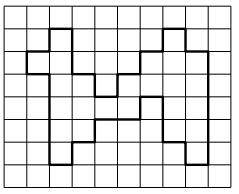Problems
Is it possible to cut this figure, called "camel"
a) along the grid lines;
b) not necessarily along the grid lines;
into \(3\) parts, which you can use
to build a square?
(We give you several copies to facilitate drawing)



The triangle \(ABC\) is equilateral.
The point \(K\) is chosen on the side
\(AB\) and points \(L\) and \(M\) are on the side \(BC\) in such a way that \(L\) lies on the segment \(BM\). We have the following properties:
\(KL = KM,\) \(BL = 2,\, AK = 3.\) Find the length of
\(CM\).

Consider a quadrilateral \(ABCD\). Choose a point \(E\) on side \(AB\). A line parallel to the diagonal \(AC\) is drawn through \(E\) and meets \(BC\) at \(F\). Then a line parallel to the other diagonal \(BD\) is drawn through \(F\) and meets \(CD\) at \(G\). And then a line parallel to the first diagonal \(AC\) is drawn through \(G\) and meets \(DA\) at \(H\). Prove the \(EH\) is parallel to the diagonal \(BD\).
There are \(16\) cubes, each face of every cube is coloured yellow, black, or red (different cubes can be coloured differently). After looking at their colouring pattern, Pinoccio said that he could put all the cubes on the table in such a way that only the yellow color would be visible, on the next turn he could put the cubes in such a way that only the black color would be visible, and also he could put them in such a way that only the red color would be visible. Is there a colouring of the cubes such that he could tell the truth?
Find the representation of \((a+b)^n\) as the sum of \(X_{n,k}a^kb^{n-k}\) for general \(n\). Here by \(X_{n,k}\) we denote coefficients that depend only on \(k\) and \(n\).
The positive real numbers \(a, b, c, x, y\) satisfy the following system of equations: \[\left\{ \begin{aligned} x^2 + xy + y^2 = a^2\\ y^2 + yz + z^2 = b^2\\ x^2 + xz + z^2 = c^2 \end{aligned} \right.\]
Find the value of \(xy + yz + xz\) in terms of \(a, b,\) and \(c.\)
Find all solutions of the system of equations: \[\left\{ \begin{aligned} (x+y)^3=z\\ (x+z)^3=y\\ (y+z)^3=x \end{aligned} \right.\]
Find a representation as a product of \(a^{2n+1} + b^{2n+1}\) for general \(a,b,n\).
Find a representation as a product of \(a^n - b^n\) for general \(a,b,n\).
Each integer on the number line is coloured either white or black. The numbers \(2016\) and \(2017\) are coloured differently. Prove that there are three identically coloured integers which sum to zero.